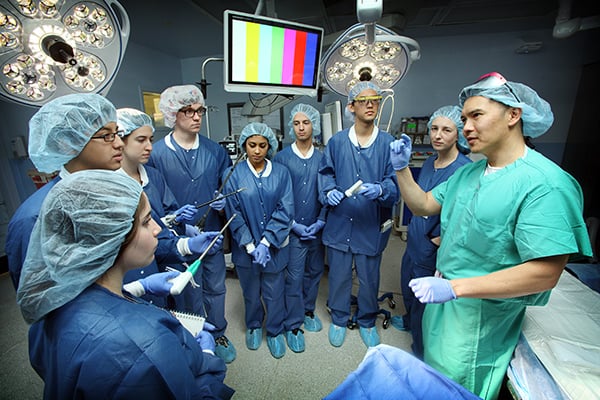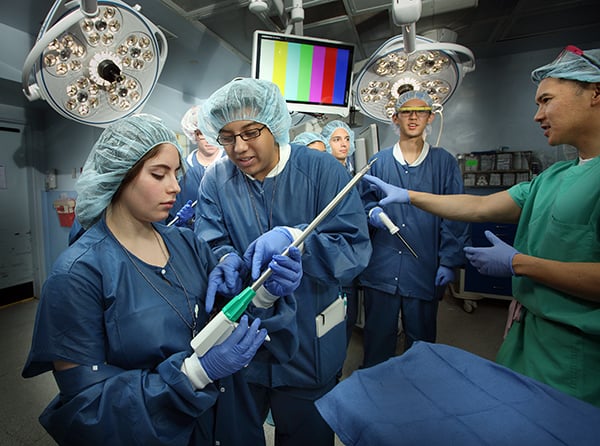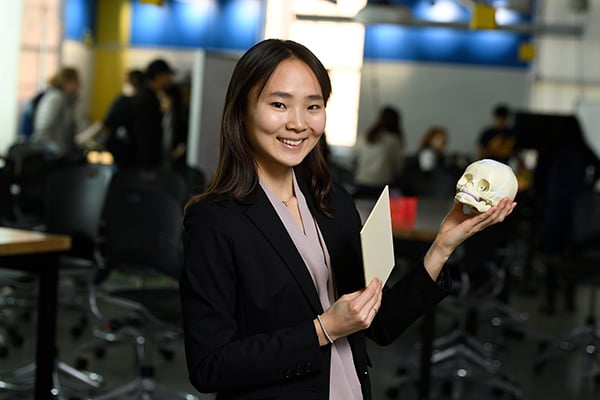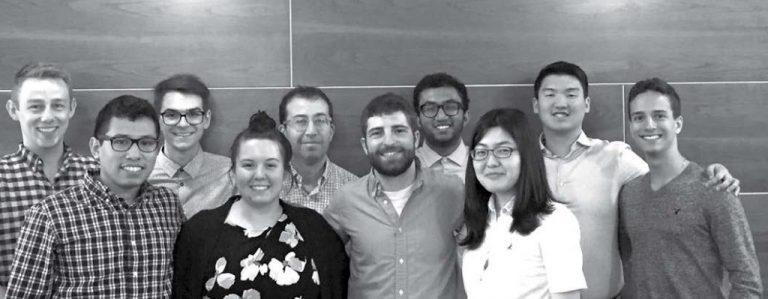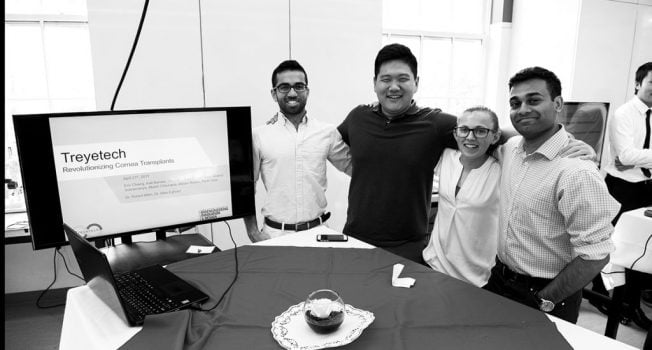But the program is about much more than patents, grants, and competitions. All Design Team experiences—not just the small number of projects that reach commercial fruition—are powerful learning experiences, says Nicholas Durr, assistant professor of biomedical engineering and the director of the undergraduate Design Team courses. Students gain a real-world sense of how to work through cycles of design and prototyping, how to communicate effectively with clinicians, how to develop business plans and assert intellectual property, and how to collaborate in groups with diverse skills and interests.
“Every project is completely different,” Durr says. “What’s useful for one team is not what’s going to be useful for the next.”
Durr’s colleague Elizabeth Logsdon, the Department of Biomedical Engineering’s director of undergraduate advising and a lecturer who co-teaches the Design Team courses, notes that the courses have few lectures and relatively little didactic content. Instead, the student teams mostly work independently in more than 5,000 square feet of design space in the BME Design Studio, which has a 24-hour video connection to a companion space—the Carnegie Center for Surgical Innovation—in the Johns Hopkins Hospital’s Carnegie Building. If a team hits an obstacle and needs help with coding, stress-testing, machine fabrication, or business plan writing, Logsdon and Durr will connect them with a faculty member or clinical mentor who can teach them the relevant skills.
But whatever strategies they might use to tackle their clinical problem, each Design Team faces no-nonsense deadlines. Every two weeks, each team undergoes a desk review, in which the course’s faculty members grill them on their progress. And roughly once a month, each team presents its work to its primary clinical sponsor and other clinician mentors. By the end of the spring semester, they’re expected to submit polished business plans and professional-grade reports on their prototyping and testing.
On a cold afternoon in February, Fujita’s group is convening in full for the first time after the winter break. While they were away, a long-awaited package arrived: a box of realistic foam skulls designed for surgical training. Now they finally have something to test their piezoelectric instruments on. As they open the box, one of Fujita’s teammates searches online to confirm that these models are, as advertised, similar to the density of actual infant bones.
Before they start drilling, Fujita gives a beginning-of-the-semester pep talk. As the spring semester starts, Fujita’s team—like all other Design Teams—has expanded from five students to eight, as three first-year students have joined.
“There are more of us now,” Fujita says, “and we should probably start to work in subgroups. It’s important for each person to take initiative in their role.”
“I know I want to focus on making the instruments,” says fourth-year Olivia Musmanno. She intends to do a series of rapid silicone prototypes using the BME Design Studio’s 3-D printers. Once they’ve achieved their design specifications, the team will have metal prototypes cast in the fabrication center. All the while, the students need to be mindful of the team’s annual budget, although many groups secure additional money for their projects via grants, corporate sponsorships, or business plan competitions, which often bring in tens of thousands of dollars.
Musmanno intends to go to medical school, after a gap year or two. “I plan to be a surgeon,” she says. “Hopefully a reconstructive surgeon, but definitely a surgeon. But I’d still like to be a designer of medical devices.”
Across the Design Studio this afternoon, groups are having similar conversations. One team is working on new methods to keep peritoneal-dialysis catheters safe from infection. Another is building a device to measure blood flow within the spinal cord in patients with severe injuries. All told, there are 13 teams in this year’s undergraduate cohort but as many as 40 ongoing projects including efforts from previous years (see “Tackling Tacrolimus,” below).
As the teams huddle over their projects, they’re visited by Michelle Zwernemann ’08, MS ’13, who serves as staff engineer for the Design Team courses. She joined the faculty in the fall of 2017 after several years of work at a prosthetics firm, and she tends to ask blunt questions. “I want to help these students avoid the pain points that new engineers often face when they start out in industry,” she says.
Also making rounds this afternoon is Amir Manbachi, a lecturer who serves as the Design Team courses’ third major faculty member, along with Durr and Logsdon. Manbachi co-invented and patented a spinal surgery device while he was a graduate student at the University of Toronto a decade ago. “As engineers, we may not treat patients ourselves, but we have the opportunity to build devices or solutions that can save thousands of lives,” he says.
One of the central challenges of the Design Team process, Durr says, is establishing the right kind of rapport between the clinicians and the engineering students. “We encourage teams to treat their clinical adviser as part of the team rather than a source of clinical knowledge,” Durr says.
Clinicians occasionally submit project proposals that are too complex or ambitious for undergraduate design teams, Durr adds. In those cases, the clinicians are encouraged to collaborate with students in the master’s degree program at the Center for Bioengineering Innovation and Design.
Students who assume team leader roles, as Fujita did at the beginning of 2017, take an additional course centered on project management, clinical exposure, and interpersonal dynamics.
Fujita, who plans to take a gap year before starting medical school, says that Design Team has been one of the strongest experiences she’s had during her undergraduate years. “The great thing about it is that they give us time to start slowly and to learn about the clinical problem,” she says. “We spent the fall semester reading papers, interviewing clinicians, and observing Dr. Ahn and Dr. Iyer in the operating room.”
Ahn says that inviting novice engineers into the operating room has helped his team of surgeons rethink their clinical challenges. “We’re used to doing things a certain way,” he says, “but these engineering students can help suggest methods we may never have thought of.”
That kind of deep clinical immersion—hours to collaborate with clinicians in their working environments—is one of the strengths of Design Team coursework, Durr says. “We want to teach our students to carefully observe processes and procedures in health care before they ever start building anything,” he says. “The whole point of Design Team is to encourage that productive understanding between clinicians and engieers.”
With any luck, infants with craniosynostosis five years from now will reap the benefit of that understanding.

